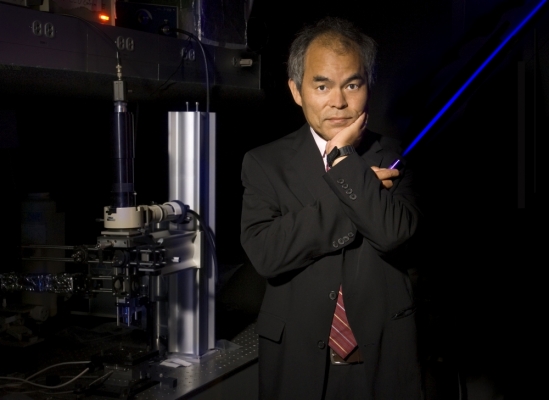In recognition of his groundbreaking work in LED (light-emitting diode) technology, UC Santa Barbara materials professor Shuji Nakamura has been chosen as a 2015 Global Energy Prize Laureate. The prestigious Russian award “honors outstanding achievements in energy research and technology from around the world that are helping address the world’s various and pressing energy challenges.”
“I am so pleased that the Global Energy Prize committee has recognized my breakthrough work on InGaN LEDs, which has led to energy-efficient white LED lighting,” said Nakamura, who was one of three 2014 Nobel Prize winners in physics for the invention of the bright blue LED. This was an innovation that would lead to the creation of the white LED and the ability to save energy, reduce carbon emissions and provide a low energy, durable and sustainable light source for those with little or no access to electricity.
 |
|
UCSB Professor and Soraa founder Shuji Nakamura. (Randall Lamb) |
“We are so proud to congratulate our colleague Shuji Nakamura on this prestigious recognition as a Global Energy Prize Laureate,” said UC Santa Barbara Chancellor Henry T. Yang. “The applications and consequences of his pioneering work in solid-state lighting continue to grow, with far-reaching impact on fields ranging from information and communication, to energy and the environment, to health care and life sciences. By making it possible to bring affordable, energy-efficient lighting to developing countries, Professor Nakamura has made a tremendous humanitarian contribution to our world.”
Ubiquitous in today’s electronics, from cellphones to cars, computer and television displays to interior lighting, LED technology took decades to develop, beginning with red LEDs in the 1960s, followed by green, orange and yellow. Blue LEDs were the most challenging to invent and were the remaining primary color needed to make white LED light. Nakamura took on the challenge, not only using the very promising but notoriously difficult semiconductor material gallium nitride (GaN), but also inventing a means to manufacture high-quality GaN crystals. He debuted his high-efficiency bright blue LED in 1993.
Now a professor of materials and of electrical and computer engineering at UCSB, Nakamura is also the co-director of the campus’s Solid State Lighting & Energy Electronics Center (SSLEEC), where his research focuses on growth and device fabrication of light-emitters based on gallium nitride.
“The Solid State Lighting and Energy Electronics Center is so pleased that LED lighting is saving the world billions in energy costs and with further potential to bring cost-effective lighting to the developing world,” said Steve DenBaars, professor of materials and SSLEEC co-director.
This award is the latest in a stream of honors for Nakamura, including the Nishina Memorial Award (1996), the Materials Research Society Medal (1997), the Institute of Electrical and Electronics Engineers’ Jack A. Morton Award, the British Rank Prize (1998), the Benjamin Franklin Medal (2002), the Millennium Technology Prize (2006), the Czochralski Award (2007), the Prince of Asturias Award for Technical Scientific Research (2008), The Harvey Award (2009), the Technology and the Engineering Emmy Award (2011), the LED Pioneer Award (2012), the Nobel Prize in Physics (2014), Japan’s Order of Culture Medal (2014) and the Charles Stark Draper Prize (2015).
Nakamura joins 31 Energy Prize laureates from 10 countries. Winners have included prominent scientists such as Arthur Rosenfeld (U.S.A), awarded for his pioneering work in energy-efficient buildings; Akira Yoshino (Japan), recognized for the invention of lithium ion batteries; and Thorsteinn Ingi Sigfusson (Iceland); honored for developing hydrogen into a viable alternative power source in Iceland. Nakamura will receive his award at the Saint Petersburg International Economic Forum on June 19.





 CN
TW
EN
CN
TW
EN






